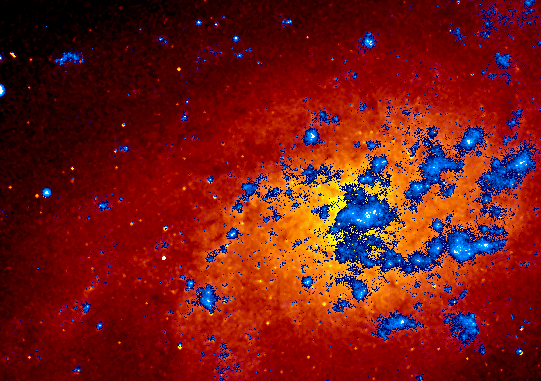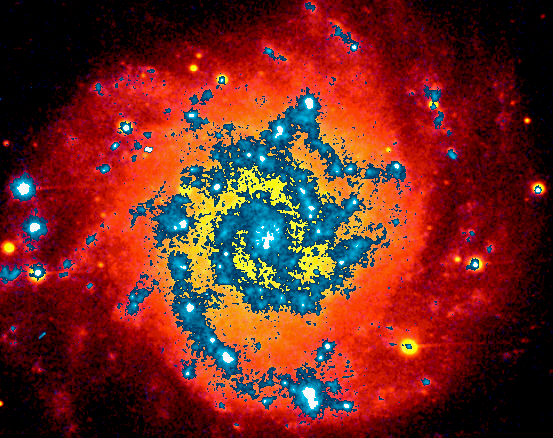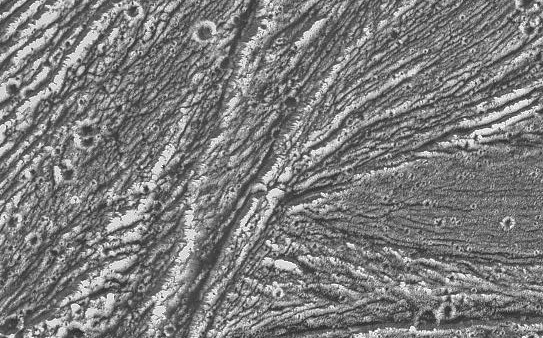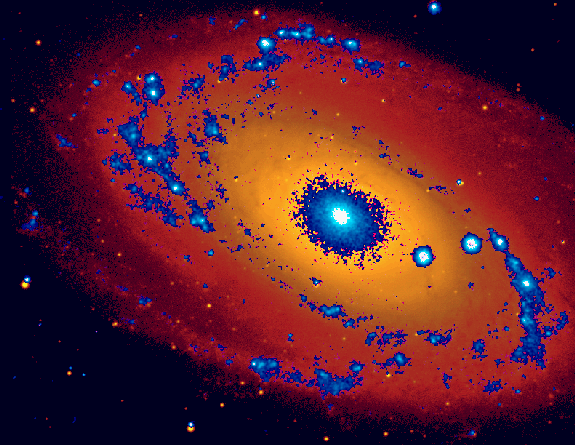NASA APOD #385-391
#385 Tomorrow's picture: July 08, 1996
“The spiral galaxy M33 is a mid-sized member of our Local Group of galaxies. M33 is also called the Triangulum Galaxy for the constellation in which it resides. About four times smaller (in radius) than our Milky Way Galaxy and the Andromeda Galaxy (M31), it is much larger than the many of the local dwarf spheroidal galaxies. M33's proximity to M31 causes it to be thought by some to be a satellite galaxy of this more massive galaxy. M33's proximity to our Milky Way galaxy causes it to appear more than twice the angular size of the full moon, and visible with a good pair of binoculars. In the above picture, visible light is shown in red and ultraviolet light superposed in blue. Stars in M33 are the most distant ever to be studied spectroscopically."
Copyright: Public domain
#386 Tomorrow's picture: July 09, 1996
“M74 is about the same size as our own Milky Way Galaxy. Like our Milky Way, M74 is classified a spiral galaxy. M74's sweeping lanes of stars and dust combined with its small nucleus make it a classic Grand Design Spiral. On the Hubble Sequence of Galaxies, M74 is listed as "Sc". In the above picture, visible light is shown in red and ultraviolet light superposed in blue. In general, older stars are more red and younger stars are blue. Studies with the Ultraviolet Imaging Telescope show that the disk of M74 has undergone significant star formation in just the past 500 million years."
Copyright: Public domain
#387
APOD's Archive of Galileo at Ganymede
July 10, 1996
“Ganymede's surface is slowly being pulled apart. This photo of Ganymede was released earlier today by the Galileo team at NASA. The Galileo Spacecraft arrived at Jupiter in December 1995. In late June, the spacecraft passed within 10,000 kilometers of Ganymede's icy surface, and took pictures showing complex surface details for the first time. The line-like features in this photo are sunlit ridges rising above Ganymede's ice-plains. The circular features are impact craters. Ganymede is the largest moon of Jupiter and hence the largest of the four Galilean satellites: Io, Europa, Ganymede, and Callisto. APOD's Archive of Galileo at Ganymede"
Copyright: Public domain
#388
APOD's Archive of Galileo at Ganymede
July 11, 1996
“Ganymede's surface is a wrinkled mess. As large ice-sheets shift on the moon's surface, parts of the surface buckle causing high ridges, deep furrows, and parallel grooves. This photo, taken by the Galileo spacecraft currently orbiting Jupiter, was released yesterday. The large circular feature near the picture bottom is a large impact crater. The impact that caused this large crater also caused the strange dark ejecta seen to the crater's right. The Sun illuminates the scene from the lower left. The Galileo spacecraft has also just discovered that Ganymede has a region of orbiting charged particles called a magnetosphere - a first for any moon. How Ganymede is able to generate a magnetosphere is a mystery. APOD's Archive of Galileo at Ganymede"
Copyright: Public domain
#389
APOD's Archive of Galileo at Ganymede
July 12, 1996
“The largest moon in the Solar System shows regions that are ancient and battered. The high density of craters demonstrate that patches of Ganymede are indeed billions of years old. This photo is one of a series released by NASA two days ago from the Galileo spacecraft orbiting Jupiter. The large impact crater on the left is 19 kilometers across, while dark indentations in Ganymede's crusty surface-ice run diagonally. Ganymede is composed of half rock and half water-ice. The Galileo spacecraft will continue to orbit Jupiter over the next 16 months and send back data about Jupiter and its four largest moons: Io, Europa, Ganymede, and Callisto. APOD's Archive of Galileo at Ganymede"
Copyright: Public domain
#390 Tomorrow's picture: July 13, 1996
“Few stars are still forming in the old giant spiral galaxy M81. The blue regions in this picture - representing ultraviolet light - highlight regions of bright young stars and star formation and appear rare than in M74 and M33. The red regions - representing the visible light - show a large population of older, less massive stars. M81 is therefore classified as spiral galaxy type "Sab" on the Hubble Sequence of Galaxies. One distinguishing feature of these types of galaxies is the relatively large central bulge surrounding the center of the galaxy. A massive density wave circulates around the center of spiral galaxies. It is not well understood why the bulge of M81 glows as bright as it does in ultraviolet light. Speculation includes that this may be due to hot evolved stars such as those found in the ancient globular cluster Omega Centauri."
Copyright: Public domain
#391 Tomorrow's picture: July 14, 1996
“Here's what a spiral galaxy REALLY looks like. Yesterday, M81 was shown in two colors only, but here we see M81 at its most colorful. In the above picture, note how blue the spiral arms are - this indicates the presence of hot young stars and on-going star formation. Also note the yellow hue of the nucleus, possibly designating a population of older stars many billions of years old. M81 is actually a dominant member of a group of galaxies which includes M82 and several other galaxies. Unlike our Local Group of galaxies, large galaxies in the M81 group are actually colliding. It is possible that M81's interaction with M82 create the density waves which generate M81's spiral structure."
Copyright: Public domain
Upvote! Resteem! Comment! As you like it! Thank you for attention!






